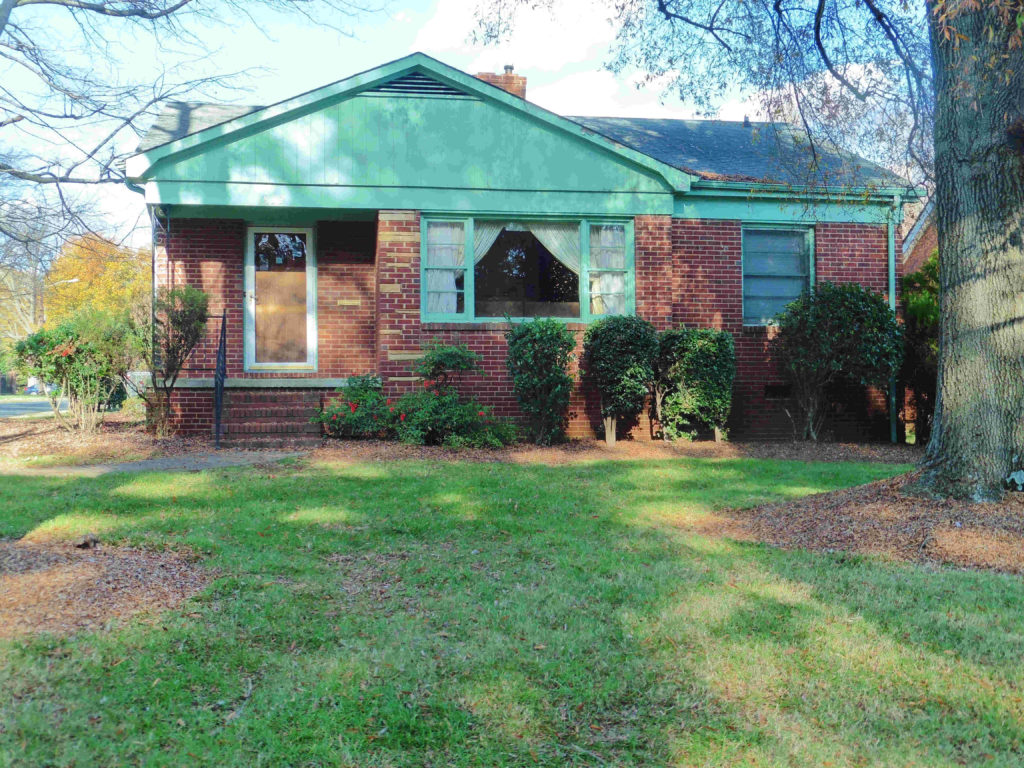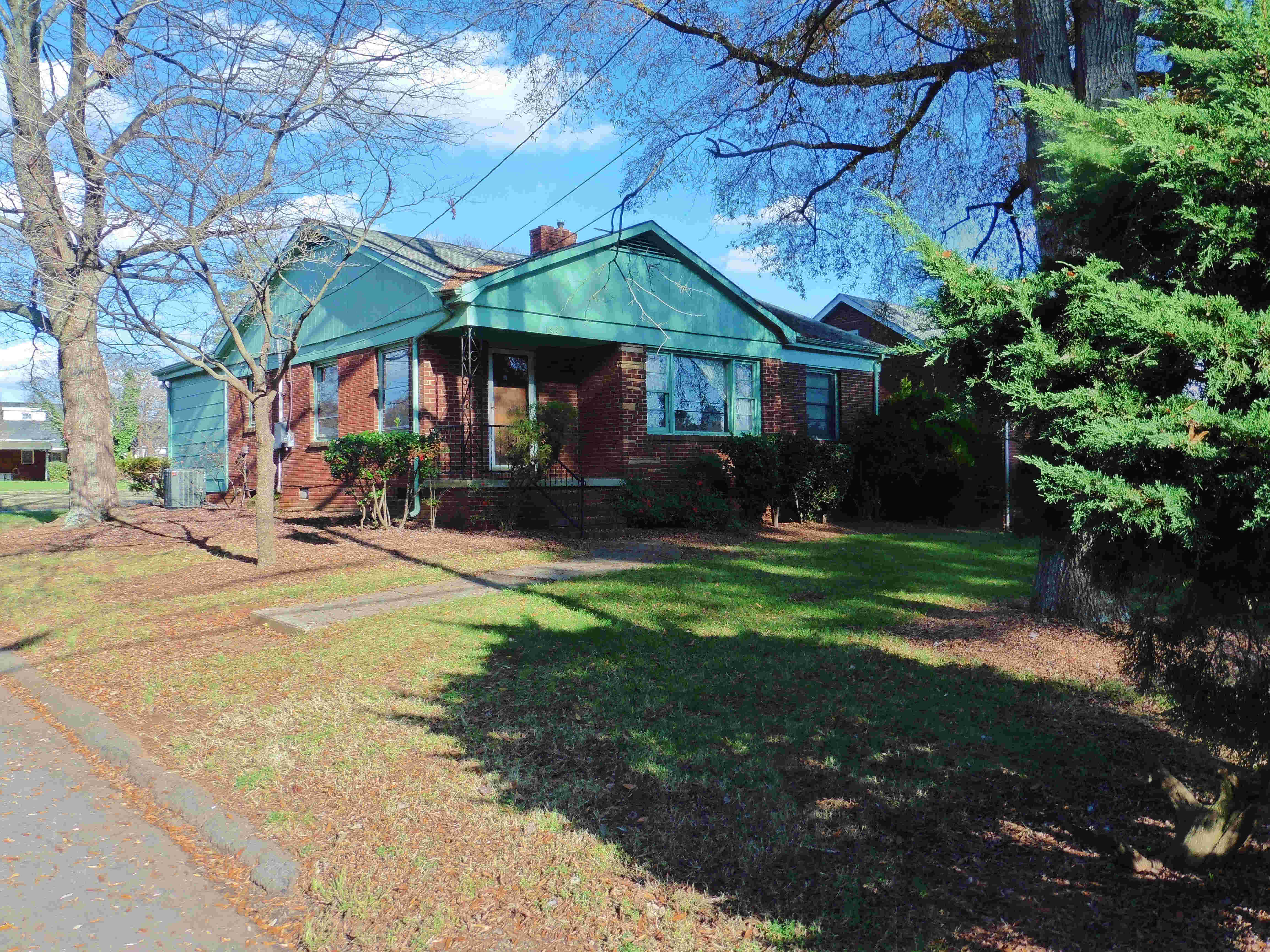1822 Patton Avenue
 Built 1954 for Edgar C. Goodwin, founder and longtime leader of Charlotte’s McCrorey YMCA, and wife Florence Cannon Goodwin, a public health nurse.
Built 1954 for Edgar C. Goodwin, founder and longtime leader of Charlotte’s McCrorey YMCA, and wife Florence Cannon Goodwin, a public health nurse.
Charlotte native Edgar Cephus Goodwin (11.25.1920 – 7.18.1991) graduated from Johnson C. Smith University in 1944. He had studied for the ministry, but instead took a job as Executive Secretary (the top administrator) at the fledgling Second Street YMCA in 1946. He immediately set about raising funds for a permanent building. The large modernistic structure opened in 1951 as the McCrorey YMCA, honoring Johnson C. Smith University President (and McCrorey Heights developer) H.L. McCrorey in the last year of his life. The building still stands, part of the United Way office complex on Third Street between Brevard Street and Caldwell Street.
In the early 20th century, YMCAs were much more than the exercise centers they often are today. The organization’s founders conceived them as “safe spaces” for people who were moving from country to city in large numbers in that era. YMCAs offered fellowship, healthy team sports, religious guidance and often a place to cheaply rent minimal housing — a welcome antidote to the taverns and lonely flophouses where newcomers often went astray in this new urban world. Indeed Booker T. Washington, the noted black proponent of African American striving and uplift, had played a large role in making sure that YMCAs were built in black as well as white urban neighborhoods in the organization’s early years around 1900.
When the Brooklyn neighborhood around the YMCA fell to the bulldozers of Urban Renewal in the late 1960s, the McCrorey YMCA was spared by the city’s white leaders – something of a testament to the respect that Goodwin’s work had earned. But with the neighborhood gone, it was tough for YMCA members to get to the facility. So Goodwin set about a second round of fundraising. In 1972 a new McCrorey YMCA opened on Beatties Ford Road about two miles beyond McCrorey Heights.
Once he saw the building complete, Edgar Goodwin stepped down. He became an Employment Counselor for the City of Charlotte, doing some of the same sort of “life skills” work with young people that he had at the Y — doubly important now that African Americans were breaking into formerly “white” jobs as Civil Rights advances took hold. After a ten year stint he retired in 1982.
Faith and community spirit motivated Goodwin’s work. “Edgar spent his life in the Presbyterian tradition,” his funeral program emphasized. “As a youth and young adult he was an active member of Amay James Presbyterian Church where he served the Sunday School and youth ministries.” Started by energetic teacher/social worker Amay James in the 1920s, the church became an important civic force on Charlotte’s West Boulevard corridor. In his maturity, Goodwin “was a faithful and loyal member of Memorial Presbyterian Church, having served on the Board of Deacons, Christian Action Committee, the Men’s Council and the Sunday School.” He also joined civic organizations outside the church, including Alpha Phi Alpha Fraternity and the Scorpions Social Club.
Edgar Goodwin married Florence Cannon Goodwin (2.7.1921 – 4.12.2010) in 1944. She came from Cheraw, South Carolina, and had attended Coulter Academy there, a private black high school support by the Presbyterian Church, before coming to Charlotte to earn a nursing degree at Good Samaritan Hospital. She worked first as a nurse at Good Sam, then hired on as a Public Health Nurse in Charlotte’s recently-formed public health department, one of the first in the South. She stayed with the job 34 years, retiring in 1983. Mrs. Goodwin and her husband raised two daughters in this house: Cynthia Goodwin Bullock and Tanita Goodwin Toliver.
Like her husband, Florence Goodwin was a staunch Presbyterian and also enjoyed participation in many community groups. Said her funeral program: “Mrs. Goodwin was a long-standing member of Memorial Presbyterian Church where she served on the Board of Trustees, the Presbyterian Women, the Memorial Presbyterian Church Bible Study and the Retirees Fellowship. She was active both civically and socially. She was a charter member of the Charlotte Chapter of Jack and Jill, Inc. [a national group that helped youngsters from well-educated African America families meet and connect with each other], a member of the Monday Evening Bridge Club, the Merry Makers, the Gayettes, [two local African American social clubs] as well as a member of the Good Samaritan Alumni Association. She was a charter member of the Iota Chapter [of] Chi-Eta Phi Nursing Sorority and the Young at Hearts. For many years she was a dedicated volunteer with Loaves and Fishes.”

Architecture
This one-story house combines elements of Cottage and Ranch styles. It is relatively compact in massing, with a prominent front gable — both characteristic of the Cottage style. But its horizontality, including a wide three-part “picture” window in the front living room, is characteristic of the Ranch Style. The main roof has a gable-end to the west and a hip-end to the east. A front gable projects toward the street, sheltering the living room plus an inset front porch with a single “wrought iron” column. Exterior walls are red brick, with horizontal blond stone accents near the front door. At the rear of the house, a small porch appears to have been enclosed with wooden clapboard siding, probably by the original owner. The house sits at the corner of Mulberry Avenue facing Patton Avenue.
Building permit
Patton-1822-permit-b
Date issued: August 31, 1953
Owner: E. C. Goodwin
Contractor: Erwin Construction Co.
Other permit info: to build residence
Building permit files, Robinson-Spangler Carolina Room, Charlotte Mecklenburg Library.
First appeared in city directory
1955 – Edgar C. Goodwin & Florence C.
He: Executive Secretary, YMCA. She: Nurse, City Health Dept.
1981 – Edgar C. Goodwin & Florence C.
He: Human Services Assistant, Employment Training Dept.
City directory collection, Robinson-Spangler Carolina Room, Charlotte Mecklenburg Library.
obituary
Goodwin,_Edgar, funeral program in the Obituary Project notebooks, African American Genealogy Interest Group collection, Robinson-Spangler Carolina Room, Charlotte Mecklenburg Library.
Goodwin,_Florence, funeral program in the collection of Memorial Presbyterian Church, Charlotte.
Resources
All-Black Governing Bodies: The History and Contributions of All-Black Governing Bodies in the Predecessor Denominations of the Presbyterian Church (USA). (Louisville, Kentucky: Office of the General Assembly, Presbyterian Church (USA), 1996), pp. 87 – 88. On-line at: http://www.chicagopresbytery.org/wp-content/uploads/2012/03/All-Black-Governing-Bodies.pdf
“A History of Amay James Presbyterian Church, from Its Mission State, 1922, Up to the Present, 1959.” On-line at: http://cdm16324.contentdm.oclc.org/cdm/ref/collection/p15170coll10/id/241
Paula Lupkin, Manhood Factories: YMCA Architecture and the Making of Modern Urban Culture (Minneapolis: University of Minnesota Press, 2010).
Minutes of Mecklenburg Presbytery, 1941. On-line at: https://archive.org/stream/minutesofmecklen07pres/minutesofmecklen07pres_djvu.txt
“Official Opening and Dedication of the Henry Lawrence McCrorey Branch of the Young Men’s Christian Association of Charlotte, N.C., April 15, 1951.” Pamphlet in the collection of Inez Moore Parker Archives, Johnson C. Smith University. On-line at: http://cdm15170.contentdm.oclc.org/cdm/singleitem/collection/p15170coll5/id/561/rec/1